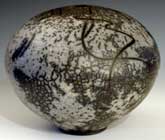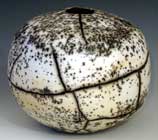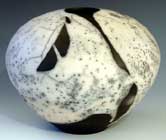|
At this point, you can do some carving through the slip/glaze surface so that when it is reduced
post firing, what you carve will show through with black lines. I usually scribe some free-form loops, lines and scratches. I
let the slip/glaze dry on the pot completely before I fire it.
The type of clay is also important, since it must have enough grog in the body to withstand the stress of a raku firing. The best finishes are on pots which have been well burnished, and have a
smooth non-pitted surface.
Most stoneware clay bodies with medium sized grog do very well.
When I fire, I slowly fire the kiln until it's just hot enough to
begin to flux the glaze. When I see it just start to bubble up and release its gasses, and has an "orange peel"
surface across the entire pot, I pull it out of the kiln. This is in the ball park of 1400-1500º F. I like to blow on the glaze surface to promote some crazing in the glaze, then insert the pot into a reduction chamber (garbage can) full of combustibles (news paper, sawdust) to reduce the pot as it cools. Reducing in pine shavings and sawdust
gets me the darkest boldest crazing patterns, and deep black
where there are any unglazed areas exposed. I will let the pot
cool in the can only about 5 to 10 minutes. At this point I pull out the pot, and either dunk it in water, or spray it with water. When the still very warm pot is hit with the water, most of the slip/glaze should pop off the pot revealing the
desired surface below. I will continue to squirt it with water, and using a thin flexible metal rib,
carefully scrape the rest of the slip/glaze from the entire pot.
When finished scraping, I scrub it gently with fine steel wool
or a green scrubbie under running water to get any remaining traces of slip off the pot. Sometimes I coat it with a diluted solution of water and Future floor wax. This gives the pot a soft sheen, while bringing out the blacks in the surface.
My naked raku slip &
glaze recipes
| Naked Raku Slip |
Naked Raku Glaze |
50% - Lincoln fire clay
20% - #6 tileclay kaolin
20% - Fine grog
10% - Custer feldspar |
65% - Ferro Frit 3110
35% - Gerstley Borate
|
|




